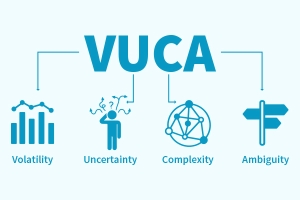‘Times are a-changin’.
No one knows this better than the current crop of business leaders. The tried and tested or the formulaic way of managing people and leading business is no longer effective in a world where continuous changes and disruptions are the new normal.
A survey conducted by Deloitte ‘2019 Global Human Capital Trends’ revealed that to 80% of business heads, managing the unknown or adapting to disruptive changes was the major challenge. This included the challenge of navigating complex and ambiguous business processes, managing remote staff, and embracing automation while still keeping the ‘human’ element of work-culture alive.
Each of these challenges indicates that we are living in a ‘VUCA’ world where business leaders might not get the stability they crave.
Not just a managerial buzzword
What is VUCA? A staple term in corporate circles and business publications, VUCA is more than just a new-age corporate jargon. It stands for volatility, uncertainty, complexity, and ambiguity. In simple words, VUCA can be summed up as a set of uncertainties that business owners face.
Volatility indicates a constant rate of change. For example, a natural disaster may lead to a price fluctuation due to a lack of suppliers.
Uncertainty refers to a state of unpredictability due to a lack of information or resources. You don’t know why something has happened and what can be done to address it.
Complexity implies interdependent systems that do not exhibit a clear cause and effect. Some information may be predicted but the volume or pattern can be difficult to process or decipher. Example: Multinational corporations have to face a complex, multi-layered business process as they conduct business in many countries and have to deal with different regulations, markets, and cultural obstacles.
Ambiguity refers to the problem of establishing structure in an unfamiliar and volatile ecosystem. No precedents exist so you cannot refer to a case study to dictate your next move. For example, if a business decides to capture a new or emerging market or launch a product completely out of its core competency. Today’s leaders seem to be stuck in a stage where there is a perpetual period of VUCA.
The elements of VUCA are not new. Every business has faced challenges of wading through stranger tides when starting a business in a new sector or when they went through lean phases due to uncontrollable factors such as natural disasters or a pandemic.
However, the 21st century has amplified these challenges due to a multitude of factors such as globalization, hyper digitalization, and tech innovations. Changes even big disruptive ones are not an occasional hazard for entrepreneurs anymore but an everyday reality.
When change is the only constant, businesses have to become more agile and be ready to be in ‘on-the-go’ mode for long periods. In the age of VUCA these are the new requirements of organizations when it comes to the workforce:
- Remote staff that can be relied upon to work autonomously.
- An agile leadership that can incite trust and competency without physical proximity.
- A workforce that can adjust easily with automation and large-scale implementation and work with tech a digital tools to be more responsive to customers.
VUCA vs VUCA?
According to seasoned HR practitioners, the antidote for the VUCA world is also known as VUCA! This new acronym is shorthand for Vision, Understanding, Clarity, Agility.
Vision- A rock-solid vision is the only thing that can counter volatility. When the company enters into troubled waters due to a lean phase or for some unforeseen factors such as a pandemic or national crisis, having a strong company vision and set of values might be the only compass needed to make the management, as well as the workforce, stay motivated.
Employees need to be given some flexibility to adapt to the organizational changes but the organizational vision -i.e the touchstone of the company be it innovation or setting new standards in customer satisfaction must never be compromised.
Understanding – Uncertainty can be difficult to deal with. Leaders often have no blueprint to refer to. However just because the crisis your business is facing seems to be a novel one, that does not mean there is no scope for mitigation. Sometimes all that’s needed is to observe and understand.
- Conduct in-depth research on business and competitive intelligence.
- Stay up-to-date with industry news
- A major issue when facing uncertainty is the lack of any case study based on which you can detect a pattern and formulate a strategy. In this case, you can simulate situations, to understand how people might react to such circumstances in near future. Gaming and role-playing can be useful tools to develop foresight.
Clarity – Communication gaps can be a major problem in the VUCA world. Where the management can anticipate a change of plans or strategy at any time, the communication between team members needs to be on-point and constant. The leadership must also be ready to help the workforce brush up their knowledge on the company’s values to ensure that no decision taken either by employees or the upper management goes against what the organization stands for.
Agility – As we have stated before, change is the only constant in the VUCA era. So you have to hire employees who would thrive amidst chaos. The existing workforce who are habituated to working in a certain way may be expected to step outside their comfort zone, think and work outside their usual responsibilities. Upskilling and cross-training may be the way to help team members develop agility.
L&D plays a huge role in the era of VUCA
An agile, tech-savvy and hyper-responsive, and flexible workforce is the need of the hour. A dynamic learning culture is however a requisite for building such a workforce. L&D initiatives can help employers upgrade the skills and knowledge of their employees so that they can be more resilient and adapt to tech innovations.
Through the right courses in innovation and inspirational leadership, managers will be able to help the employees to respond to challenges independently without being overly dependent on authority, while still keeping the business priorities in mind.
Disruptions are a given in the VUCA world. If the team does not have the skills needed to meet new or additional responsibilities then they would not be able to adapt to organizational changes. Upskilling is the only way employees can remain relevant in the VUCA world. These skills may include problem-solving skills, project management knowledge, digital know-how, etc.
Corporate training is also needed to make the workforce more resilient. Uncertainty and ambiguity – about responsibilities, line of decision making, and job roles are the names of the game when it comes to the VUCA world. Many employees may feel vulnerable from having to deal with stressful situations 24X7. Short-term programs that focus on positivity and mental well-being will be necessary to keep the workforce engaged and motivated.
How L&D Managers Can Create Impactful Learning in a VUCA World?
Make learning self-paced
Rapid skill development is a necessity if employees have to meet a new set of challenges frequently. VUCA work environments often operate on a remote/hybrid mode so the traditional top-down hierarchical system of training may not prove effective here. Employees will often have no time to sign up for a course and set aside a separate time to attend it. They may have to absorb new skills and complete a project within the same day. So arranging for self-paced modules will be necessary.
Be more agile
If frequent organizational changes are the new norm, then L&D managers have to leverage data to identify skill gaps and arrange training where required and do it fast.

